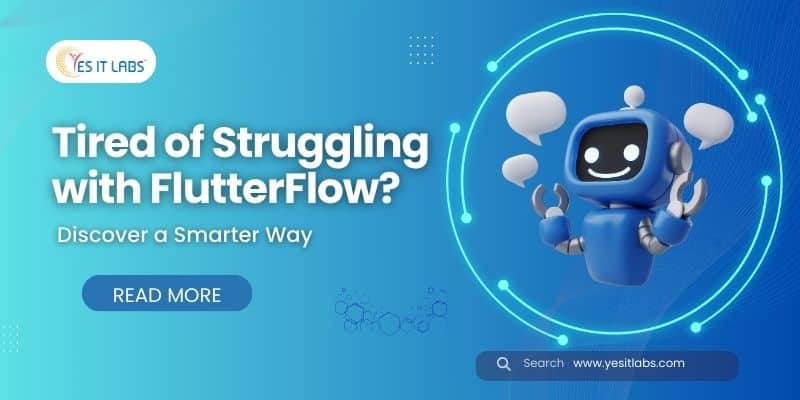The promise of no-code and low-code platforms like FlutterFlow is undeniably appealing—faster development, visual UI building, and a lower barrier to entry for app creation. For startups, freelancers, and even enterprises, it seems like the perfect shortcut to getting a mobile app up and running.
But if you’ve spent any real time inside FlutterFlow, you may have experienced a different reality: incomplete features, limited customization, unclear documentation, and constant troubleshooting. Sound familiar? You’re not alone.
If you’re tired of battling with FlutterFlow and feeling stuck halfway through your app project, you’re not the problem. The tool might be limiting your vision. Let’s break down the struggle and explore a smarter, scalable approach to mobile app development—one that brings your full vision to life.
The FlutterFlow Hype: Why It Starts Strong but Fizzles Fast
At first glance, FlutterFlow appears to be a game-changer. It lets you build cross-platform apps using a drag-and-drop interface with minimal coding. It supports Firebase integration, custom functions, and even exports Flutter code.
However, as your app requirements get more complex—custom animations, third-party APIs, advanced authentication, or intricate logic—the platform quickly begins to feel restrictive. You realize you’re spending hours trying to “hack” a solution using workarounds or external packages. And if you’re not a developer, this becomes overwhelming fast.
Moreover, apps built purely in FlutterFlow often lack long-term scalability. They may be great prototypes or MVPs, but the real world of business needs something more durable and flexible.
When Visual Tools Become a Bottleneck
The idea behind tools like FlutterFlow is to simplify development—but ironically, they can make things more complicated as you scale. Here’s why:
- Customization Ceiling: Need that feature slightly modified? Too bad—unless you export code and start coding manually.
- Performance Constraints: Apps created purely through visual builders can become bloated and laggy, especially when scaling.
- Limited Plugin Ecosystem: You’re tied to what FlutterFlow supports out of the box, which isn’t always enough.
- Team Collaboration Issues: While great for solo builders, working with multiple developers in a visual platform introduces version control nightmares.
If your project’s ambition grows beyond a to-do list app, you’ll hit walls fast. This is where the smarter route emerges: combining professional development expertise with your vision.
A Smarter Way: Go Beyond the Builder
Let’s face it—no tool can replace skilled developers. While FlutterFlow is useful for prototyping, transitioning to a full-fledged, scalable solution often requires experienced hands to rewrite and extend your app’s codebase. This is where partnering with a tech team or hiring seasoned developers makes all the difference.
Instead of bending your goals to fit within FlutterFlow’s limitations, imagine building the exact app you envisioned—with full control over functionality, performance, and design.
Real Developers, Real Results
Whether you’re a startup founder with a brilliant idea or a growing business ready to digitize services, having an experienced team to back you up accelerates your journey.
For instance, if you’re building an app for Android users and want it to run smoothly across a variety of devices, the best way forward is custom Android app development using native or cross-platform frameworks like Flutter—but by real developers, not just visual tools.
This approach ensures that your app is tailored to your business logic, user experience standards, and security needs—without relying on workaround-heavy solutions that might break later.
When and Why to Hire Android Developers
There comes a point when DIY tools fall short. If you’ve reached that point, it’s time to hire Android developers who can translate your ideas into robust, scalable solutions. Professional developers bring:
- Expertise in native and cross-platform frameworks
- Deep knowledge of app architecture and backend integrations
- Security best practices and code optimization
- Scalable infrastructure and long-term support
They can also take your exported FlutterFlow project and elevate it—adding logic, integrating advanced APIs, improving UI/UX, and optimizing performance. It’s about turning your MVP into a market-ready product.
Scaling Across Platforms: Don’t Leave iOS Behind
While many start with Android, most successful apps go cross-platform. That’s where iOS app development comes in. Having a development team that understands Apple’s ecosystem—App Store requirements, Swift integration, device-specific optimizations—ensures your app shines across both platforms.
Relying on FlutterFlow alone may lead to inconsistent behaviors between Android and iOS, especially when you push beyond basic functionality. A smarter strategy is to design for both platforms from day one, with experts who know how to manage codebases efficiently.
Case Study: From FlutterFlow to Fully Custom App
Let’s take an example. A startup founder used FlutterFlow to build a learning app MVP. It looked great at first, but soon hit a snag:
- Payment gateway integration was clunky
- User authentication with OTP was unreliable
- The app crashed when handling large video files
After partnering with a development team, the app was rebuilt using Flutter—with clean, maintainable code, real backend logic, and third-party services integrated seamlessly. The result? A smooth, secure, and scalable app, now used by over 50,000 students.
This is the transformation that happens when you stop struggling with limited tools and start working smarter with the right partners.
Why This Matters for Your Business
Your app is more than a visual design—it’s a digital extension of your business. Whether you’re building a marketplace, fitness tracker, booking system, or internal enterprise tool, it has to work reliably, scale smoothly, and delight users.
Instead of burning time wrestling with visual builders that weren’t made for complex apps, partner with a team that gets it right from the start. It saves you cost, time, and the headache of rebuilding everything later.
How to Transition from FlutterFlow the Right Way
If you’ve already started with FlutterFlow, you don’t have to scrap everything. Here’s how to shift gears smoothly:
- Export Your Codebase: FlutterFlow allows you to export Flutter code, which a dev team can build upon.
- Assess Gaps: Work with experts to identify limitations and areas that need custom solutions.
- Define Your Long-Term Vision: What does success look like in 6 months? 1 year? Ensure your tech stack supports that.
- Build with Scale in Mind: Implement backend systems, databases, and integrations that can grow with your users.
- Focus on Performance and Security: Optimize the code, implement encryption, and test extensively.
Final Thoughts: It’s Time to Work Smarter, Not Harder
FlutterFlow has its place. It’s great for idea validation, early prototypes, and even quick MVPs. But when you’re aiming for real impact—when your app needs to handle real users, real data, and real business logic—you need more than a visual builder.
Don’t let the tool limit your ambition. Whether it’s Android or iOS, prototype or production, you deserve a development approach that evolves with your vision.
So if you’re tired of struggling with FlutterFlow, maybe it’s time to stop trying to fix the tool—and start building the future you imagined.
Need help making the transition? Our team specializes in custom app development, taking your idea from FlutterFlow or scratch to a scalable, high-performance product. Let’s talk about how we can bring your vision to life—the smarter way.








